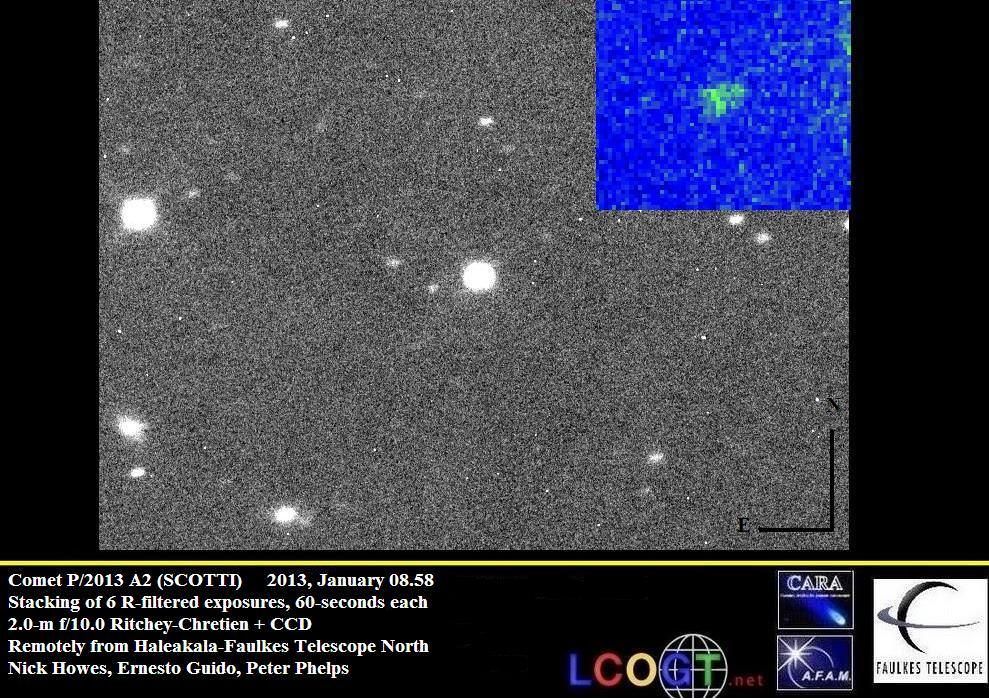This week is the BBC’s Stargazing Live, and there have been all sorts of events in the UK for what has become a national stargazing celebration. Excitingly, during one event where astronomers were coordinating imaging with students in UK schools, a new comet was discovered.
“To say we’re over the moon would be an understatement,” said Nick Howes, who is the Faulkes Telescope Pro-Am programme manager. He along with his colleague at the Remanzacco Observatory in Italy, Ernesto Guido helped facilitate the discovery. “This was one of the trickiest comets we’ve ever worked on, faint at magnitude 20, with a minuscule tail. It took all our efforts for several hours to confirm it with the 2 meter scopes. It’s fantastic that with the third episode of Stargazing Live coming up and focusing on comets, that we managed to nail this one during the airing of the live show.”
This is the third year of Stargazing Live, which brings together astronomical societies, museums and discovery centers for local events as well as live broadcasts on the BBC.
Howes and Guido decided on trying to image this target, as analysis of the Minor Planet Centre’s NEOCP target list showed that one of the newly detected but as yet unclassified objects was likely to be a comet.
“We’d selected this target based on the preliminary data published by the minor planet center,” Howes said, “but then the power of social networking helped out even more.”
With only one set of limited observations on it by the Spacewatch Observatory, Howes communicated via the social network site Twitter with Jim Scotti, an astronomer in Arizona, who first observed this object.
“It became clear from speaking to Jim, that they thought they had something, but in following with IAU rules would not say what,” Howes said. “But he encouraged us to perform additional observations to make sure what we had was indeed what we suspected from the orbit…a new comet!”
The new object at magnitude 20, billions of times fainter than the human eye can see was then imaged by Howes and Guido using Faulkes Telescope North.
Fortunately, the elevation of the comet in the sky also permitted them to request additional observations from Peter Phelps at Hazlemere school in the UK. “The data from Faulkes North was not 100% clear, as the object was so faint, but we suspected it was a comet, and asked for more images,” Howes said.
The extra images, from Faulkes South showed the comet very near to a bright field star, but were enough to convince Howes and Guido that it was indeed a comet.
The minor planet center later on the 8th January confirmed this and cited the Faulkes observations in the discovery circular and telegrams:
The new Comet is called P2012 A2 Scotti CBET is 3376 Cbet nr. 3376, issued on 2013, January 08, announces the discovery of a new comet (discovery magnitude 19.5) by J. Scotti with the 691 Steward Observatory, Kitt Peak, on images obtained with the 0.9-m f/3 reflector + CCD on January 06.2. The new comet has been designated P/2013 A2 (SCOTTI).
The team have been observing and imaging comets and asteroids all week with UK schools, and on Wednesday January 9th had a full day devoted to detecting and refining orbits on Kuiper belt objects in the far reaches of the solar system with a large number of schools. This is part of an ongoing research collaboration with the Lowell Observatory in Arizona.
Congrats to all involved!
Sources: Nick Howes, Remanazacco Observatory


“The new object at magnitude 20, billions of times fainter than the human eye can see”
Each five magnitudes is 100x, and the human eye can easily see magnitude 5, so this is not even a million times fainter than the human eye can see. 🙂
Great work! It is particularly fitting to have discovered it during a live broadcast.
Thats just awesome!